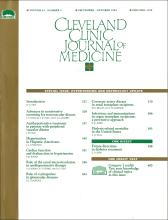ABSTRACT
BACKGROUND Some specific treatment goals are indicated for patients with hypertension complicated by peripheral vascular disease.
OBJECTIVE To review the available information about treating hypertension in patients with atherosclerosis or aneurysms of the aorta or peripheral arteries.
SUMMARY Patients with peripheral vascular disease and hypertension should be treated according to the general guidelines for all patients with hypertension. However, specific treatment goals include improvement or stabilization of intermittent claudication and associated conditions such as coronary artery disease, hyperlipidemia, and diabetes mellitus. The ideal therapy for most of these conditions is nonpharmacologic: achievement of ideal body weight, a diet low in cholesterol, saturated fat, and salt, and a regular exercise program will improve blood pressure control, lipid values, blood glucose control, insulin sensitivity, symptoms of intermittent claudication, and long-term survival. Patients who smoke should stop. Patients with aneurysms should receive beta blockers.
CONCLUSIONS Antihypertensive therapy in patients with peripheral vascular disease should be part of a general program of risk-factor reduction.
- Copyright © 1994 The Cleveland Clinic Foundation. All Rights Reserved.






